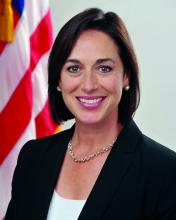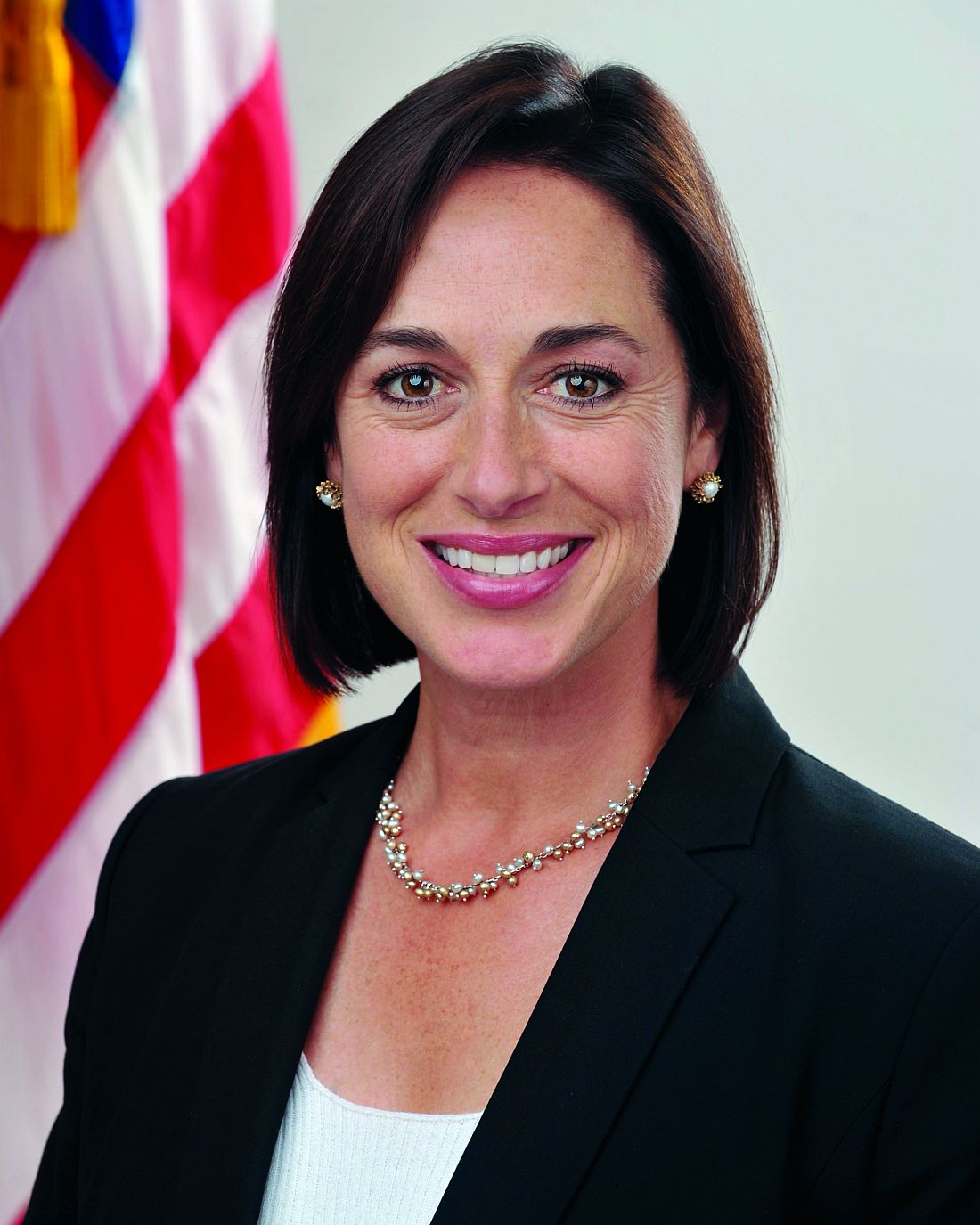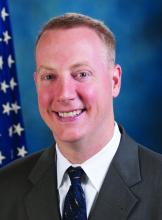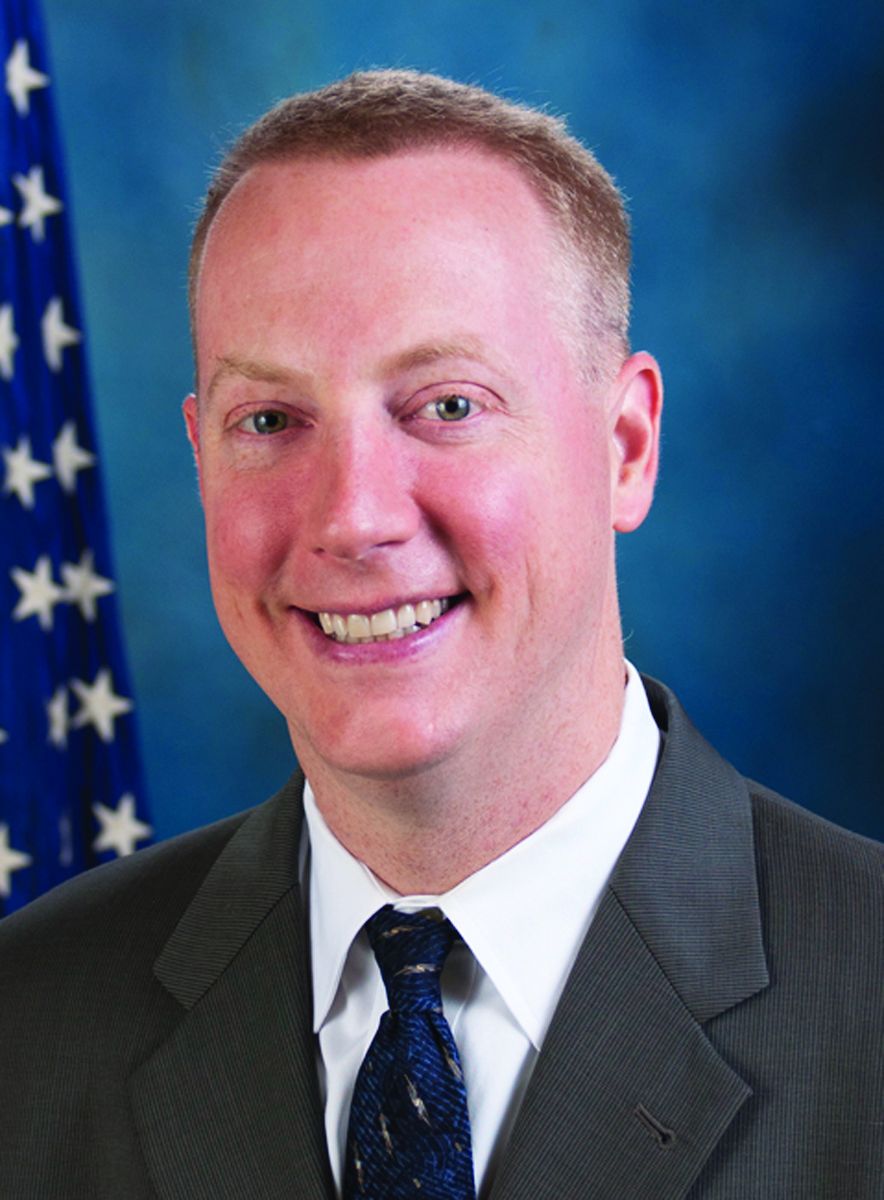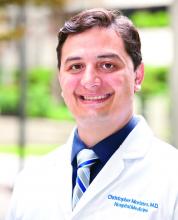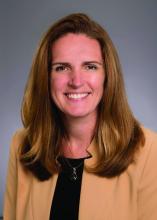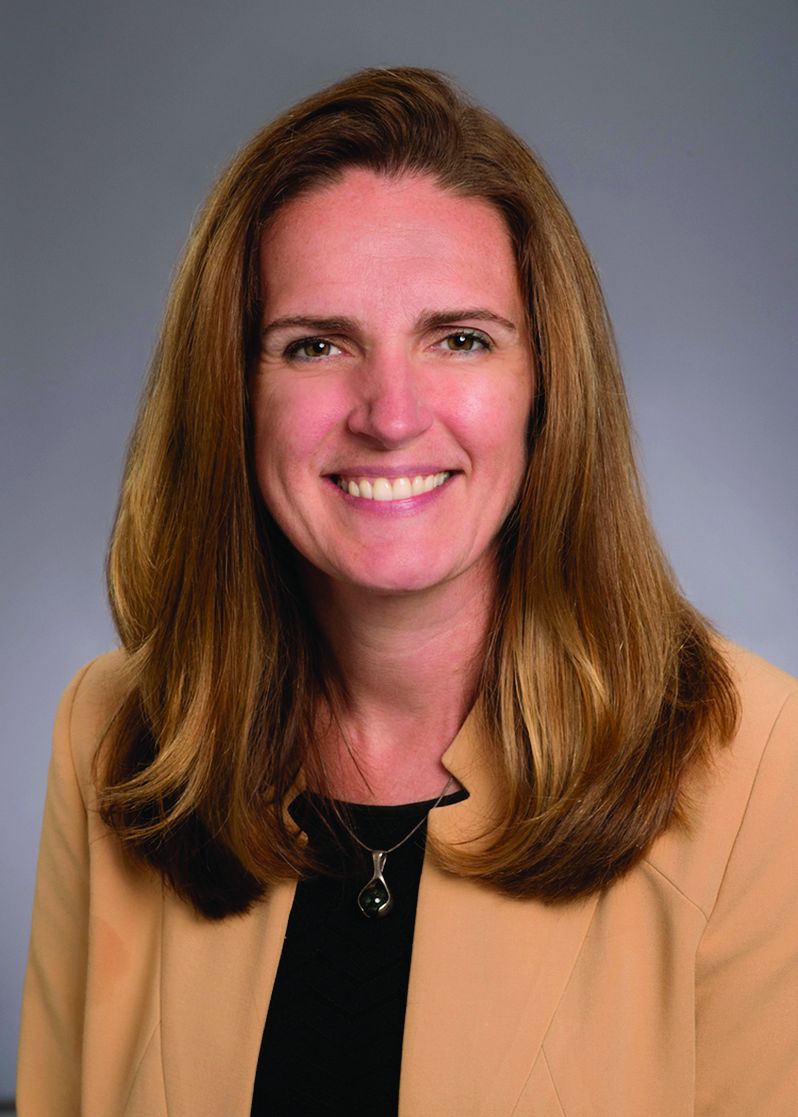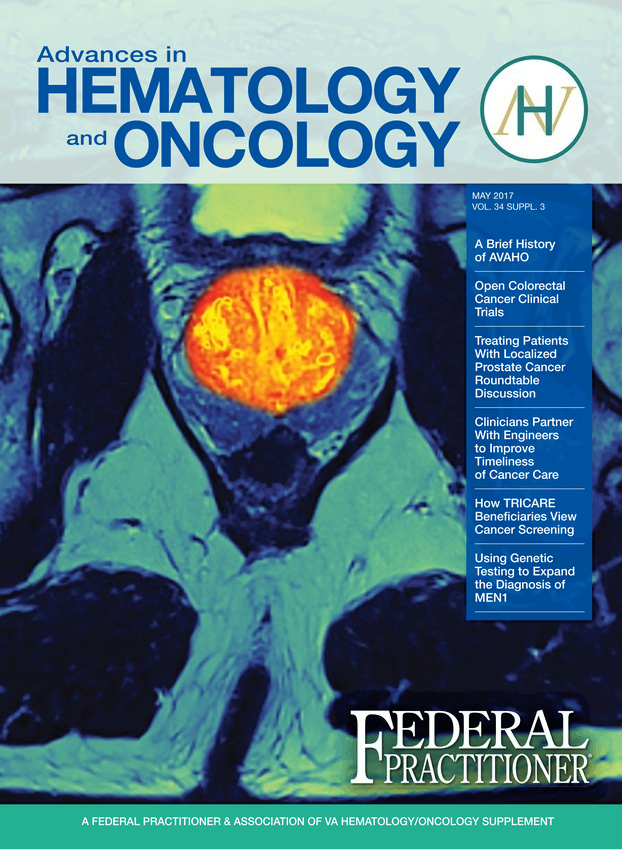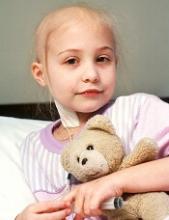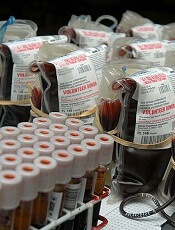User login
Optimism in the face of change
The first HM17 plenary is focused on health policy at a time when a dynamically evolving health care delivery system may seem daunting, opaque, and labyrinthine.
“Though it feels uncertain in some ways, the health care world is pretty united that we need to continue the progress we’ve made on moving away from the old fee-for-service model, toward one that lets people practice medicine the way they want and focus on patients and outcomes,” said HM17 keynote speaker Karen DeSalvo, MD, MPH, MSc, former acting assistant secretary for health in the U.S. Department of Health and Human Services (HHS).
“That’s just the way that we finance or pay for care,” she said. “There’s this entire care system that everybody’s working and innovating in every day, trying to find more efficient, effective ways to get better outcomes. Hospitalists, quite frankly, have been in the lead for 20 years and really understand in granular detail what it takes.”
Dr. DeSalvo believes that the progress of the past 5 years has already laid the path that must now be followed. The public sector’s move away from fee for service, toward payment for episodic care, has combined with emerging technology platforms to create a new age in which physicians and insurers can judge, in real-time, how well care is working.
Add to this the growth of accountable care organizations, other alternative payment models, value-based purchasing, and the implementation of the Medicare Access and CHIP Reauthorization Act of 2015 (MACRA), and it is clear the direction in which the industry is headed.
Of course, Dr. DeSalvo understands the fears of those wondering where the next wave of change will carry them. She’s heard the political debate over the past 8 years and the rancorous discussions in just the first few months of 2017. But she believes the path for health care delivery continues to be “toward the natural place as opposed to the unnatural place.”
“That gives me a lot of optimism,” she said. “One of the most important things for hospitalists to be doing right now is to keep standing up and speaking on behalf of patients and saying that the right thing is for us not to regress but to continue moving forward so that we can all have the kind of system we want for our patients.
The first HM17 plenary is focused on health policy at a time when a dynamically evolving health care delivery system may seem daunting, opaque, and labyrinthine.
“Though it feels uncertain in some ways, the health care world is pretty united that we need to continue the progress we’ve made on moving away from the old fee-for-service model, toward one that lets people practice medicine the way they want and focus on patients and outcomes,” said HM17 keynote speaker Karen DeSalvo, MD, MPH, MSc, former acting assistant secretary for health in the U.S. Department of Health and Human Services (HHS).
“That’s just the way that we finance or pay for care,” she said. “There’s this entire care system that everybody’s working and innovating in every day, trying to find more efficient, effective ways to get better outcomes. Hospitalists, quite frankly, have been in the lead for 20 years and really understand in granular detail what it takes.”
Dr. DeSalvo believes that the progress of the past 5 years has already laid the path that must now be followed. The public sector’s move away from fee for service, toward payment for episodic care, has combined with emerging technology platforms to create a new age in which physicians and insurers can judge, in real-time, how well care is working.
Add to this the growth of accountable care organizations, other alternative payment models, value-based purchasing, and the implementation of the Medicare Access and CHIP Reauthorization Act of 2015 (MACRA), and it is clear the direction in which the industry is headed.
Of course, Dr. DeSalvo understands the fears of those wondering where the next wave of change will carry them. She’s heard the political debate over the past 8 years and the rancorous discussions in just the first few months of 2017. But she believes the path for health care delivery continues to be “toward the natural place as opposed to the unnatural place.”
“That gives me a lot of optimism,” she said. “One of the most important things for hospitalists to be doing right now is to keep standing up and speaking on behalf of patients and saying that the right thing is for us not to regress but to continue moving forward so that we can all have the kind of system we want for our patients.
The first HM17 plenary is focused on health policy at a time when a dynamically evolving health care delivery system may seem daunting, opaque, and labyrinthine.
“Though it feels uncertain in some ways, the health care world is pretty united that we need to continue the progress we’ve made on moving away from the old fee-for-service model, toward one that lets people practice medicine the way they want and focus on patients and outcomes,” said HM17 keynote speaker Karen DeSalvo, MD, MPH, MSc, former acting assistant secretary for health in the U.S. Department of Health and Human Services (HHS).
“That’s just the way that we finance or pay for care,” she said. “There’s this entire care system that everybody’s working and innovating in every day, trying to find more efficient, effective ways to get better outcomes. Hospitalists, quite frankly, have been in the lead for 20 years and really understand in granular detail what it takes.”
Dr. DeSalvo believes that the progress of the past 5 years has already laid the path that must now be followed. The public sector’s move away from fee for service, toward payment for episodic care, has combined with emerging technology platforms to create a new age in which physicians and insurers can judge, in real-time, how well care is working.
Add to this the growth of accountable care organizations, other alternative payment models, value-based purchasing, and the implementation of the Medicare Access and CHIP Reauthorization Act of 2015 (MACRA), and it is clear the direction in which the industry is headed.
Of course, Dr. DeSalvo understands the fears of those wondering where the next wave of change will carry them. She’s heard the political debate over the past 8 years and the rancorous discussions in just the first few months of 2017. But she believes the path for health care delivery continues to be “toward the natural place as opposed to the unnatural place.”
“That gives me a lot of optimism,” she said. “One of the most important things for hospitalists to be doing right now is to keep standing up and speaking on behalf of patients and saying that the right thing is for us not to regress but to continue moving forward so that we can all have the kind of system we want for our patients.
Elders and Falls Lead TBI-Related ED Visits
Nearly 3 million emergency department (ED) visits, hospitalizations, and deaths were related to traumatic brain injury (TBI) in 2013, according to researchers from the National Center for Injury Prevention and Control. The age-adjusted rate of ED visits was higher in 2013 than in 2007 (787.1 vs 534.4), a change driven largely by people aged ≥ 75 years, who accounted for 18% of the increase in the number of TBI-related ED visits.
Related: Ideas for Helping TBI Patients
The most common mechanisms of injury in the study were falls, being struck by or against an object, and motor-vehicle crashes. Particular age groups were disproportionately affected by specific mechanisms. The researchers say about half of all fall-related TBI visits/hospitalizations/deaths were among babies, toddlers, and adults aged > 75 years.
Those data suggest an urgent need for more and stronger fall-prevention efforts, say the researchers. In older adults, TBIs are more likely to lead to hospitalizations that can be complicated by comorbidities. Moreover, the researchers say, older adults are more likely to use anticoagulants, which can increase the likelihood of intracranial hemorrhage.
Related: Making Fall Prevention “Routine”
Prevention strategies that have proved effective in randomized controlled trials include multicomponent exercise programs, tai chi, vitamin D supplements, cataract surgery, and making the home environment safer. The CDC also has developed the Stopping Elderly Accidents Deaths and Injuries (STEADI) program, which incorporates empirically supported clinical guidelines and scientifically tested interventions to help primary care providers address fall risk and use effective interventions.
Nearly 3 million emergency department (ED) visits, hospitalizations, and deaths were related to traumatic brain injury (TBI) in 2013, according to researchers from the National Center for Injury Prevention and Control. The age-adjusted rate of ED visits was higher in 2013 than in 2007 (787.1 vs 534.4), a change driven largely by people aged ≥ 75 years, who accounted for 18% of the increase in the number of TBI-related ED visits.
Related: Ideas for Helping TBI Patients
The most common mechanisms of injury in the study were falls, being struck by or against an object, and motor-vehicle crashes. Particular age groups were disproportionately affected by specific mechanisms. The researchers say about half of all fall-related TBI visits/hospitalizations/deaths were among babies, toddlers, and adults aged > 75 years.
Those data suggest an urgent need for more and stronger fall-prevention efforts, say the researchers. In older adults, TBIs are more likely to lead to hospitalizations that can be complicated by comorbidities. Moreover, the researchers say, older adults are more likely to use anticoagulants, which can increase the likelihood of intracranial hemorrhage.
Related: Making Fall Prevention “Routine”
Prevention strategies that have proved effective in randomized controlled trials include multicomponent exercise programs, tai chi, vitamin D supplements, cataract surgery, and making the home environment safer. The CDC also has developed the Stopping Elderly Accidents Deaths and Injuries (STEADI) program, which incorporates empirically supported clinical guidelines and scientifically tested interventions to help primary care providers address fall risk and use effective interventions.
Nearly 3 million emergency department (ED) visits, hospitalizations, and deaths were related to traumatic brain injury (TBI) in 2013, according to researchers from the National Center for Injury Prevention and Control. The age-adjusted rate of ED visits was higher in 2013 than in 2007 (787.1 vs 534.4), a change driven largely by people aged ≥ 75 years, who accounted for 18% of the increase in the number of TBI-related ED visits.
Related: Ideas for Helping TBI Patients
The most common mechanisms of injury in the study were falls, being struck by or against an object, and motor-vehicle crashes. Particular age groups were disproportionately affected by specific mechanisms. The researchers say about half of all fall-related TBI visits/hospitalizations/deaths were among babies, toddlers, and adults aged > 75 years.
Those data suggest an urgent need for more and stronger fall-prevention efforts, say the researchers. In older adults, TBIs are more likely to lead to hospitalizations that can be complicated by comorbidities. Moreover, the researchers say, older adults are more likely to use anticoagulants, which can increase the likelihood of intracranial hemorrhage.
Related: Making Fall Prevention “Routine”
Prevention strategies that have proved effective in randomized controlled trials include multicomponent exercise programs, tai chi, vitamin D supplements, cataract surgery, and making the home environment safer. The CDC also has developed the Stopping Elderly Accidents Deaths and Injuries (STEADI) program, which incorporates empirically supported clinical guidelines and scientifically tested interventions to help primary care providers address fall risk and use effective interventions.
Conway: HM well positioned for ‘system transformation’
Patrick Conway, MD, MSc, MHM, may have had a lot of job titles recently, but his work address hasn’t changed in 6 years.
Dr. Conway, deputy administrator for innovation and quality for the Centers for Medicare & Medicaid Services and director of its Center for Medicare and Medicaid Innovation, has been at the intersection of policy and practice in Washington, since joining CMS in 2011. The still-practicing hospitalist was acting CMS administrator for several months earlier this year, holding the top post while President Donald Trump’s nominee to lead the agency, Seema Verma, awaited U.S. Senate confirmation. His title before that was principal deputy administrator and CMS chief medical officer.
Dr. Conway said he believes that at a “macro legislation” level, Washington is committed to health care reform that improves patient care and incentivizes physicians to join alternative payment models (APMs). He said hospitalists should be encouraged by how well the field has already adapted to the proliferation of accountable-care organizations, value-based purchasing, and the Medicare Access and CHIP Reauthorization Act of 2015, or MACRA. He said that as innovations lead to better patient care and more coordinated care, that’s good for hospitalists, patients, and the hospitals that bring them together.
“I want to leave people with the idea that value-based payment innovation and delivery system reform will continue to be critical aspects of improving our health system,” he said. “I also want hospitalists to continue to stay engaged in these new payment models and help lead them and provide better patient care as part of them.”
Dr. Conway said that focusing on innovations is essential to hospitalists to ensure the specialty remains at the forefront of improved patient care, decreased readmissions, decreased infections and other quality improvements. He notes that by still practicing on an academic medical service with faculty, residents and medical students, he’s encouraged and excited that “people get it.”
“Every doctor wants better care for their patients,” Dr. Conway said. “The reality of … new payment systems and new fields of innovation we’re entering into is it unleashes hospitalists and aligns incentives with what they want for their patients.”
Take bundled payments around episodic care. With innovations in payment models, hospitalists are increasingly being paid for how good their care is, not how much care there is.
“That’s exciting,” Dr. Conway said. “Very different than 10 years ago where you had a lot of groups where it was about how much volume can we churn through. Now I think hospitals and HM groups [realize] value is going to continue to increasingly be based on the quality of care and the efficiency of care delivery.”
Patrick Conway, MD, MSc, MHM, may have had a lot of job titles recently, but his work address hasn’t changed in 6 years.
Dr. Conway, deputy administrator for innovation and quality for the Centers for Medicare & Medicaid Services and director of its Center for Medicare and Medicaid Innovation, has been at the intersection of policy and practice in Washington, since joining CMS in 2011. The still-practicing hospitalist was acting CMS administrator for several months earlier this year, holding the top post while President Donald Trump’s nominee to lead the agency, Seema Verma, awaited U.S. Senate confirmation. His title before that was principal deputy administrator and CMS chief medical officer.
Dr. Conway said he believes that at a “macro legislation” level, Washington is committed to health care reform that improves patient care and incentivizes physicians to join alternative payment models (APMs). He said hospitalists should be encouraged by how well the field has already adapted to the proliferation of accountable-care organizations, value-based purchasing, and the Medicare Access and CHIP Reauthorization Act of 2015, or MACRA. He said that as innovations lead to better patient care and more coordinated care, that’s good for hospitalists, patients, and the hospitals that bring them together.
“I want to leave people with the idea that value-based payment innovation and delivery system reform will continue to be critical aspects of improving our health system,” he said. “I also want hospitalists to continue to stay engaged in these new payment models and help lead them and provide better patient care as part of them.”
Dr. Conway said that focusing on innovations is essential to hospitalists to ensure the specialty remains at the forefront of improved patient care, decreased readmissions, decreased infections and other quality improvements. He notes that by still practicing on an academic medical service with faculty, residents and medical students, he’s encouraged and excited that “people get it.”
“Every doctor wants better care for their patients,” Dr. Conway said. “The reality of … new payment systems and new fields of innovation we’re entering into is it unleashes hospitalists and aligns incentives with what they want for their patients.”
Take bundled payments around episodic care. With innovations in payment models, hospitalists are increasingly being paid for how good their care is, not how much care there is.
“That’s exciting,” Dr. Conway said. “Very different than 10 years ago where you had a lot of groups where it was about how much volume can we churn through. Now I think hospitals and HM groups [realize] value is going to continue to increasingly be based on the quality of care and the efficiency of care delivery.”
Patrick Conway, MD, MSc, MHM, may have had a lot of job titles recently, but his work address hasn’t changed in 6 years.
Dr. Conway, deputy administrator for innovation and quality for the Centers for Medicare & Medicaid Services and director of its Center for Medicare and Medicaid Innovation, has been at the intersection of policy and practice in Washington, since joining CMS in 2011. The still-practicing hospitalist was acting CMS administrator for several months earlier this year, holding the top post while President Donald Trump’s nominee to lead the agency, Seema Verma, awaited U.S. Senate confirmation. His title before that was principal deputy administrator and CMS chief medical officer.
Dr. Conway said he believes that at a “macro legislation” level, Washington is committed to health care reform that improves patient care and incentivizes physicians to join alternative payment models (APMs). He said hospitalists should be encouraged by how well the field has already adapted to the proliferation of accountable-care organizations, value-based purchasing, and the Medicare Access and CHIP Reauthorization Act of 2015, or MACRA. He said that as innovations lead to better patient care and more coordinated care, that’s good for hospitalists, patients, and the hospitals that bring them together.
“I want to leave people with the idea that value-based payment innovation and delivery system reform will continue to be critical aspects of improving our health system,” he said. “I also want hospitalists to continue to stay engaged in these new payment models and help lead them and provide better patient care as part of them.”
Dr. Conway said that focusing on innovations is essential to hospitalists to ensure the specialty remains at the forefront of improved patient care, decreased readmissions, decreased infections and other quality improvements. He notes that by still practicing on an academic medical service with faculty, residents and medical students, he’s encouraged and excited that “people get it.”
“Every doctor wants better care for their patients,” Dr. Conway said. “The reality of … new payment systems and new fields of innovation we’re entering into is it unleashes hospitalists and aligns incentives with what they want for their patients.”
Take bundled payments around episodic care. With innovations in payment models, hospitalists are increasingly being paid for how good their care is, not how much care there is.
“That’s exciting,” Dr. Conway said. “Very different than 10 years ago where you had a lot of groups where it was about how much volume can we churn through. Now I think hospitals and HM groups [realize] value is going to continue to increasingly be based on the quality of care and the efficiency of care delivery.”
High-value care abstracts in spotlight
If the annual meeting of the Society of Hospital Medicine could be boiled down to a single goal, it might be to give hospitalists the information they need to be the best doctors they can be.
It shouldn’t come as a surprise, then, that research performed by hospitalists on high-value care (HVC) will be featured in an abstract session at this year’s conference.
The “Best of HVC Abstract Submissions” session, scheduled for Tuesday, May 2, 3:05–3:45 p.m., will be part of a day-long track devoted entirely to HVC, a new feature at this year’s annual meeting.
“The panel will give them feedback and ask questions and sort of engage in conversation about it,” Dr. Feldman said. He thinks that featuring these abstracts in a high-profile setting is a good way for hospitalists to learn from one another. “There are so many hospitalists interested in this topic right now and people working in this area and coming up with quality improvement projects around high-value care. It’s nice to know what other folks are doing.”
Dr. Feldman hopes that, if hospitalists find out what is happening at other centers, it will spur even more quality projects.
“We don’t often have the opportunity to share the work that we’ve done and to motivate each other,” he said. “When you hear about the great work that other people are doing, it is invigorating; it’s exciting; it gets you jazzed up about doing the work in your own institution. A lot of this isn’t incredibly sophisticated. It is stuff that can be relatively easily disseminated from one institution to another without having a ton of support. To be able to see the type of work that people do is thrilling for the hospitalists who attend.”
“With the growing recognition of the costs and harms from medical overuse, high-value care has become a national imperative,” he said. “Hospitalists are natural leaders for high-value care, much like we have been for patient safety and quality improvement. Hospitalists have already led the way on developing programs that target areas of overuse in hospitals. Our ‘Best of HVC’ session will highlight many of these promising examples. There will be plenty of opportunities to learn from innovators and take back the best ideas to our own hospitals.”
Organizers said that the HVC track “will guide attendees on how to avoid diagnostic and therapeutic overuse and how to move toward the right care for every hospital medicine patient.” Other sessions in the track will cover “things we do for no reason,” how to use imaging wisely, and tips on overcoming cultures fraught with overuse.
Dr. Feldman said the track is intended to meet the demand of meeting attendees.
“There are lots of hospitalists who are engaging in this type of work in their institutions and systems,” he said. “So, it’s just timely. People are engaged in it and they’re excited about it, so it makes sense that adding a track right now would fulfill the needs of many of the hospitalists who are going to be attending.”
Best of HVC Abstract Submissions
Tuesday, May 2, 3:05–3:45 p.m.
If the annual meeting of the Society of Hospital Medicine could be boiled down to a single goal, it might be to give hospitalists the information they need to be the best doctors they can be.
It shouldn’t come as a surprise, then, that research performed by hospitalists on high-value care (HVC) will be featured in an abstract session at this year’s conference.
The “Best of HVC Abstract Submissions” session, scheduled for Tuesday, May 2, 3:05–3:45 p.m., will be part of a day-long track devoted entirely to HVC, a new feature at this year’s annual meeting.
“The panel will give them feedback and ask questions and sort of engage in conversation about it,” Dr. Feldman said. He thinks that featuring these abstracts in a high-profile setting is a good way for hospitalists to learn from one another. “There are so many hospitalists interested in this topic right now and people working in this area and coming up with quality improvement projects around high-value care. It’s nice to know what other folks are doing.”
Dr. Feldman hopes that, if hospitalists find out what is happening at other centers, it will spur even more quality projects.
“We don’t often have the opportunity to share the work that we’ve done and to motivate each other,” he said. “When you hear about the great work that other people are doing, it is invigorating; it’s exciting; it gets you jazzed up about doing the work in your own institution. A lot of this isn’t incredibly sophisticated. It is stuff that can be relatively easily disseminated from one institution to another without having a ton of support. To be able to see the type of work that people do is thrilling for the hospitalists who attend.”
“With the growing recognition of the costs and harms from medical overuse, high-value care has become a national imperative,” he said. “Hospitalists are natural leaders for high-value care, much like we have been for patient safety and quality improvement. Hospitalists have already led the way on developing programs that target areas of overuse in hospitals. Our ‘Best of HVC’ session will highlight many of these promising examples. There will be plenty of opportunities to learn from innovators and take back the best ideas to our own hospitals.”
Organizers said that the HVC track “will guide attendees on how to avoid diagnostic and therapeutic overuse and how to move toward the right care for every hospital medicine patient.” Other sessions in the track will cover “things we do for no reason,” how to use imaging wisely, and tips on overcoming cultures fraught with overuse.
Dr. Feldman said the track is intended to meet the demand of meeting attendees.
“There are lots of hospitalists who are engaging in this type of work in their institutions and systems,” he said. “So, it’s just timely. People are engaged in it and they’re excited about it, so it makes sense that adding a track right now would fulfill the needs of many of the hospitalists who are going to be attending.”
Best of HVC Abstract Submissions
Tuesday, May 2, 3:05–3:45 p.m.
If the annual meeting of the Society of Hospital Medicine could be boiled down to a single goal, it might be to give hospitalists the information they need to be the best doctors they can be.
It shouldn’t come as a surprise, then, that research performed by hospitalists on high-value care (HVC) will be featured in an abstract session at this year’s conference.
The “Best of HVC Abstract Submissions” session, scheduled for Tuesday, May 2, 3:05–3:45 p.m., will be part of a day-long track devoted entirely to HVC, a new feature at this year’s annual meeting.
“The panel will give them feedback and ask questions and sort of engage in conversation about it,” Dr. Feldman said. He thinks that featuring these abstracts in a high-profile setting is a good way for hospitalists to learn from one another. “There are so many hospitalists interested in this topic right now and people working in this area and coming up with quality improvement projects around high-value care. It’s nice to know what other folks are doing.”
Dr. Feldman hopes that, if hospitalists find out what is happening at other centers, it will spur even more quality projects.
“We don’t often have the opportunity to share the work that we’ve done and to motivate each other,” he said. “When you hear about the great work that other people are doing, it is invigorating; it’s exciting; it gets you jazzed up about doing the work in your own institution. A lot of this isn’t incredibly sophisticated. It is stuff that can be relatively easily disseminated from one institution to another without having a ton of support. To be able to see the type of work that people do is thrilling for the hospitalists who attend.”
“With the growing recognition of the costs and harms from medical overuse, high-value care has become a national imperative,” he said. “Hospitalists are natural leaders for high-value care, much like we have been for patient safety and quality improvement. Hospitalists have already led the way on developing programs that target areas of overuse in hospitals. Our ‘Best of HVC’ session will highlight many of these promising examples. There will be plenty of opportunities to learn from innovators and take back the best ideas to our own hospitals.”
Organizers said that the HVC track “will guide attendees on how to avoid diagnostic and therapeutic overuse and how to move toward the right care for every hospital medicine patient.” Other sessions in the track will cover “things we do for no reason,” how to use imaging wisely, and tips on overcoming cultures fraught with overuse.
Dr. Feldman said the track is intended to meet the demand of meeting attendees.
“There are lots of hospitalists who are engaging in this type of work in their institutions and systems,” he said. “So, it’s just timely. People are engaged in it and they’re excited about it, so it makes sense that adding a track right now would fulfill the needs of many of the hospitalists who are going to be attending.”
Best of HVC Abstract Submissions
Tuesday, May 2, 3:05–3:45 p.m.
Speed-mentoring event targets junior hospitalists
When senior physicians and researchers – including hospitalists – talk about their careers, it seems they never fail to mention the mentors who helped shape their professional lives. Mentoring matters – a lot.
Junior hospitalists have a chance to receive mentoring in an area of their choice at HM17.
“This is their opportunity to get ‘rapid-fire’ advice from senior hospitalists from a variety of perspectives,” said event organizer Joanna Bonsall, MD, PhD, SFHM, assistant professor of medicine at Emory University, Atlanta.
The advisers are chosen because of their commitment to supporting career development and because of their reputation and expertise. Many of the speed mentors are returning to the event for the fourth time. It has been held at the SHM annual meeting since 2013.
“This event doesn’t replace traditional mentorship but does give junior hospitalists an opportunity to discuss an aspect of their career with multiple senior hospitalists from across the country,” Dr. Bonsall said.
When senior physicians and researchers – including hospitalists – talk about their careers, it seems they never fail to mention the mentors who helped shape their professional lives. Mentoring matters – a lot.
Junior hospitalists have a chance to receive mentoring in an area of their choice at HM17.
“This is their opportunity to get ‘rapid-fire’ advice from senior hospitalists from a variety of perspectives,” said event organizer Joanna Bonsall, MD, PhD, SFHM, assistant professor of medicine at Emory University, Atlanta.
The advisers are chosen because of their commitment to supporting career development and because of their reputation and expertise. Many of the speed mentors are returning to the event for the fourth time. It has been held at the SHM annual meeting since 2013.
“This event doesn’t replace traditional mentorship but does give junior hospitalists an opportunity to discuss an aspect of their career with multiple senior hospitalists from across the country,” Dr. Bonsall said.
When senior physicians and researchers – including hospitalists – talk about their careers, it seems they never fail to mention the mentors who helped shape their professional lives. Mentoring matters – a lot.
Junior hospitalists have a chance to receive mentoring in an area of their choice at HM17.
“This is their opportunity to get ‘rapid-fire’ advice from senior hospitalists from a variety of perspectives,” said event organizer Joanna Bonsall, MD, PhD, SFHM, assistant professor of medicine at Emory University, Atlanta.
The advisers are chosen because of their commitment to supporting career development and because of their reputation and expertise. Many of the speed mentors are returning to the event for the fourth time. It has been held at the SHM annual meeting since 2013.
“This event doesn’t replace traditional mentorship but does give junior hospitalists an opportunity to discuss an aspect of their career with multiple senior hospitalists from across the country,” Dr. Bonsall said.
Advances in Hematology and Oncology (May 2017)
Table of Contents
- Thirteen Years and Still Growing: An AVAHO History
- Criteria for Use Updates for Enzalutamide, Daratumumab, Elotuzumab, Carfilzomib, and Ixazomib
- Lung Cancer Screening: Translating Research Into Practice
- Open Clinical Trials for Patients With Colorectal Cancer
- Treatment and Management of Patients With Prostate Cancer
- Cancer Care Collaborative Approach to Optimize Clinical Care
- Patient Knowledge of and Barriers to Breast, Colon, and Cervical Cancer Screenings: A Cross-Sectional Survey of TRICARE Beneficiaries
- Novel Neuroendocrine Tumor in Multiple Endocrine Neoplasia Type 1
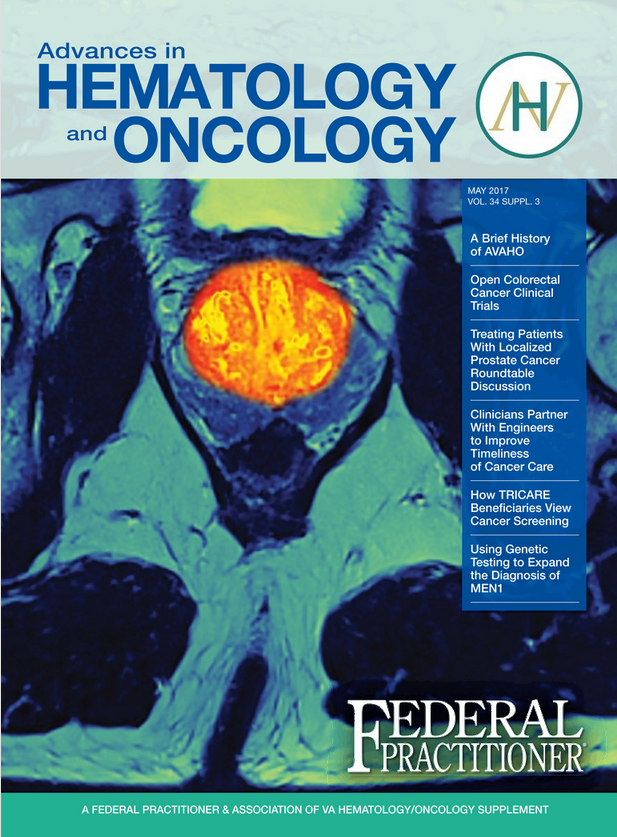
Table of Contents
- Thirteen Years and Still Growing: An AVAHO History
- Criteria for Use Updates for Enzalutamide, Daratumumab, Elotuzumab, Carfilzomib, and Ixazomib
- Lung Cancer Screening: Translating Research Into Practice
- Open Clinical Trials for Patients With Colorectal Cancer
- Treatment and Management of Patients With Prostate Cancer
- Cancer Care Collaborative Approach to Optimize Clinical Care
- Patient Knowledge of and Barriers to Breast, Colon, and Cervical Cancer Screenings: A Cross-Sectional Survey of TRICARE Beneficiaries
- Novel Neuroendocrine Tumor in Multiple Endocrine Neoplasia Type 1

Table of Contents
- Thirteen Years and Still Growing: An AVAHO History
- Criteria for Use Updates for Enzalutamide, Daratumumab, Elotuzumab, Carfilzomib, and Ixazomib
- Lung Cancer Screening: Translating Research Into Practice
- Open Clinical Trials for Patients With Colorectal Cancer
- Treatment and Management of Patients With Prostate Cancer
- Cancer Care Collaborative Approach to Optimize Clinical Care
- Patient Knowledge of and Barriers to Breast, Colon, and Cervical Cancer Screenings: A Cross-Sectional Survey of TRICARE Beneficiaries
- Novel Neuroendocrine Tumor in Multiple Endocrine Neoplasia Type 1

Chronic Lymphocytic Leukemia in the Real World
A diagnosis of chronic lymphocytic leukemia (CLL) usually occurs in people aged ≥ 72 years. But most clinical trials do not reflect that reality; thus, treatments and prognoses are based on younger patients’ experiences. Researchers from University of Pennsylvania, Emory University in Georgia, NorthShore University HealthSystem in Illinois, New York-Presbyterian Hospital/Columbia University Medical Center, Thomas Jefferson University in Pennsylvania, and Dana-Farber Cancer Institute in Massachusetts, conducted the largest comprehensive prospective evaluation of this patient population published to date to their knowledge to examine treatment patterns, outcomes, and disease-related mortality in CLL patients aged ≥ 75 years in a real-world setting.
The researchers analyzed data from patients in the Connect® CLL registry, a prospective observational cohort study that took place between 2010 and 2014 at 199 U.S. sites. Of 1,494 patients enrolled in the registry, 259 patients aged ≥ 75 years were enrolled within 2 months of starting first- line of therapy (LOT1), and 196 were enrolled in a subsequent line of therapy (LOT ≥ 2). The patients were almost entirely enrolled prior to the introduction of novel B-cell receptor-targeted therapies. The researchers say they aimed to establish a benchmark for outcomes in elderly patients with CLL who were treated before those therapies to help properly position newer agents in the treatment paradigm.
They found that elderly patients with CLL were more likely than were younger patients to receive rituximab monotherapy. In LOT ≥ 2 they were significantly less likely to receive bendamustine/rituximab. Only 6.9% of patients aged > 75 years received fludarabine/cyclophosphamide/rituximab, vs 33.7% of patients aged < 75 years. Interestingly, the researchers add, older patients were significantly more likely than were younger patients to receive chemotherapy alone without anti-CD20 antibody therapy.
Serious adverse events were more common in the elderly patients. Pneumonia was more common in elderly patients in LOT1; in LOT ≥ 2, rates of pneumonia were similar in both groups. In the follow-up with a median of 32.6 months, 433 of the 1,494 patients had died. Only 5% of patients aged < 75 years in LOT1 died of CLL, compared with 13% of elderly patients. Time to death from CLL or infection was also significantly shorter in patients aged > 75 years, compared with patients aged < 75 years. When stratified by risk, mortality due to CLL or infection was 10.3% in the lower risk group compared with 30.6% in the higher risk group.
The researchers identified 3 prognostic indicators: < 3 months from diagnosis to first treatment, enrollment therapy other than bendamustine/rituximab, and anemia. The researchers say the higher risk of CLL- or infection-related death has not, to their knowledge, been reported previously. This finding, they say, “highlights the urgent need for therapies tailored to this population.” Current therapies and strategies, they note, “appear suboptimal.”
Source:
Nabhan C, Mato A, Flowers CR, et al. BMC Cancer. 2017;17(1):198.
doi: 10.1186/s12885-017-3176-x.
A diagnosis of chronic lymphocytic leukemia (CLL) usually occurs in people aged ≥ 72 years. But most clinical trials do not reflect that reality; thus, treatments and prognoses are based on younger patients’ experiences. Researchers from University of Pennsylvania, Emory University in Georgia, NorthShore University HealthSystem in Illinois, New York-Presbyterian Hospital/Columbia University Medical Center, Thomas Jefferson University in Pennsylvania, and Dana-Farber Cancer Institute in Massachusetts, conducted the largest comprehensive prospective evaluation of this patient population published to date to their knowledge to examine treatment patterns, outcomes, and disease-related mortality in CLL patients aged ≥ 75 years in a real-world setting.
The researchers analyzed data from patients in the Connect® CLL registry, a prospective observational cohort study that took place between 2010 and 2014 at 199 U.S. sites. Of 1,494 patients enrolled in the registry, 259 patients aged ≥ 75 years were enrolled within 2 months of starting first- line of therapy (LOT1), and 196 were enrolled in a subsequent line of therapy (LOT ≥ 2). The patients were almost entirely enrolled prior to the introduction of novel B-cell receptor-targeted therapies. The researchers say they aimed to establish a benchmark for outcomes in elderly patients with CLL who were treated before those therapies to help properly position newer agents in the treatment paradigm.
They found that elderly patients with CLL were more likely than were younger patients to receive rituximab monotherapy. In LOT ≥ 2 they were significantly less likely to receive bendamustine/rituximab. Only 6.9% of patients aged > 75 years received fludarabine/cyclophosphamide/rituximab, vs 33.7% of patients aged < 75 years. Interestingly, the researchers add, older patients were significantly more likely than were younger patients to receive chemotherapy alone without anti-CD20 antibody therapy.
Serious adverse events were more common in the elderly patients. Pneumonia was more common in elderly patients in LOT1; in LOT ≥ 2, rates of pneumonia were similar in both groups. In the follow-up with a median of 32.6 months, 433 of the 1,494 patients had died. Only 5% of patients aged < 75 years in LOT1 died of CLL, compared with 13% of elderly patients. Time to death from CLL or infection was also significantly shorter in patients aged > 75 years, compared with patients aged < 75 years. When stratified by risk, mortality due to CLL or infection was 10.3% in the lower risk group compared with 30.6% in the higher risk group.
The researchers identified 3 prognostic indicators: < 3 months from diagnosis to first treatment, enrollment therapy other than bendamustine/rituximab, and anemia. The researchers say the higher risk of CLL- or infection-related death has not, to their knowledge, been reported previously. This finding, they say, “highlights the urgent need for therapies tailored to this population.” Current therapies and strategies, they note, “appear suboptimal.”
Source:
Nabhan C, Mato A, Flowers CR, et al. BMC Cancer. 2017;17(1):198.
doi: 10.1186/s12885-017-3176-x.
A diagnosis of chronic lymphocytic leukemia (CLL) usually occurs in people aged ≥ 72 years. But most clinical trials do not reflect that reality; thus, treatments and prognoses are based on younger patients’ experiences. Researchers from University of Pennsylvania, Emory University in Georgia, NorthShore University HealthSystem in Illinois, New York-Presbyterian Hospital/Columbia University Medical Center, Thomas Jefferson University in Pennsylvania, and Dana-Farber Cancer Institute in Massachusetts, conducted the largest comprehensive prospective evaluation of this patient population published to date to their knowledge to examine treatment patterns, outcomes, and disease-related mortality in CLL patients aged ≥ 75 years in a real-world setting.
The researchers analyzed data from patients in the Connect® CLL registry, a prospective observational cohort study that took place between 2010 and 2014 at 199 U.S. sites. Of 1,494 patients enrolled in the registry, 259 patients aged ≥ 75 years were enrolled within 2 months of starting first- line of therapy (LOT1), and 196 were enrolled in a subsequent line of therapy (LOT ≥ 2). The patients were almost entirely enrolled prior to the introduction of novel B-cell receptor-targeted therapies. The researchers say they aimed to establish a benchmark for outcomes in elderly patients with CLL who were treated before those therapies to help properly position newer agents in the treatment paradigm.
They found that elderly patients with CLL were more likely than were younger patients to receive rituximab monotherapy. In LOT ≥ 2 they were significantly less likely to receive bendamustine/rituximab. Only 6.9% of patients aged > 75 years received fludarabine/cyclophosphamide/rituximab, vs 33.7% of patients aged < 75 years. Interestingly, the researchers add, older patients were significantly more likely than were younger patients to receive chemotherapy alone without anti-CD20 antibody therapy.
Serious adverse events were more common in the elderly patients. Pneumonia was more common in elderly patients in LOT1; in LOT ≥ 2, rates of pneumonia were similar in both groups. In the follow-up with a median of 32.6 months, 433 of the 1,494 patients had died. Only 5% of patients aged < 75 years in LOT1 died of CLL, compared with 13% of elderly patients. Time to death from CLL or infection was also significantly shorter in patients aged > 75 years, compared with patients aged < 75 years. When stratified by risk, mortality due to CLL or infection was 10.3% in the lower risk group compared with 30.6% in the higher risk group.
The researchers identified 3 prognostic indicators: < 3 months from diagnosis to first treatment, enrollment therapy other than bendamustine/rituximab, and anemia. The researchers say the higher risk of CLL- or infection-related death has not, to their knowledge, been reported previously. This finding, they say, “highlights the urgent need for therapies tailored to this population.” Current therapies and strategies, they note, “appear suboptimal.”
Source:
Nabhan C, Mato A, Flowers CR, et al. BMC Cancer. 2017;17(1):198.
doi: 10.1186/s12885-017-3176-x.
FDA approves first ready-to-use oral solution of methotrexate
The US Food and Drug Administration (FDA) has approved a ready-to-use oral solution of methotrexate (Xatmep) for use in certain pediatric patients.
The drug is approved as part of a multi-phase, combination chemotherapy maintenance regimen to treat pediatric patients with acute lymphoblastic leukemia.
Xatmep is also approved for use in pediatric patients with active polyarticular juvenile idiopathic arthritis who have had an insufficient response to, or cannot tolerate, an adequate trial of first-line therapy, including full-dose non-steroidal anti-inflammatory agents.
Xatmep is the first ready-to-use oral solution of methotrexate to be approved by the FDA.
There was previously no such formulation of the drug approved for use in pediatric patients requiring body surface area dosing (mg/m2), patients who have difficulty swallowing or cannot consume tablets, or those with needle-phobia.
Xatmep (methotrexate) Oral Solution, 2.5 mg/mL, requires no preparation. It eliminates the need for needles, crushing or splitting tablets, or for compounding tablets into a liquid formulation.
Xatmep requires refrigeration but may be stored at room temperature for 60 days after dispensing.
For more on Xatmep, see the prescribing information, which includes a boxed warning detailing the risk of severe toxic reactions, including embryo-fetal toxicity.
Xatmep is available through pharmacies and a qualified mail-order service. For information on how to obtain the drug, call 1-855-379-0382.
Xatmep is a product of Silvergate Pharmaceuticals, Inc. ![]()
The US Food and Drug Administration (FDA) has approved a ready-to-use oral solution of methotrexate (Xatmep) for use in certain pediatric patients.
The drug is approved as part of a multi-phase, combination chemotherapy maintenance regimen to treat pediatric patients with acute lymphoblastic leukemia.
Xatmep is also approved for use in pediatric patients with active polyarticular juvenile idiopathic arthritis who have had an insufficient response to, or cannot tolerate, an adequate trial of first-line therapy, including full-dose non-steroidal anti-inflammatory agents.
Xatmep is the first ready-to-use oral solution of methotrexate to be approved by the FDA.
There was previously no such formulation of the drug approved for use in pediatric patients requiring body surface area dosing (mg/m2), patients who have difficulty swallowing or cannot consume tablets, or those with needle-phobia.
Xatmep (methotrexate) Oral Solution, 2.5 mg/mL, requires no preparation. It eliminates the need for needles, crushing or splitting tablets, or for compounding tablets into a liquid formulation.
Xatmep requires refrigeration but may be stored at room temperature for 60 days after dispensing.
For more on Xatmep, see the prescribing information, which includes a boxed warning detailing the risk of severe toxic reactions, including embryo-fetal toxicity.
Xatmep is available through pharmacies and a qualified mail-order service. For information on how to obtain the drug, call 1-855-379-0382.
Xatmep is a product of Silvergate Pharmaceuticals, Inc. ![]()
The US Food and Drug Administration (FDA) has approved a ready-to-use oral solution of methotrexate (Xatmep) for use in certain pediatric patients.
The drug is approved as part of a multi-phase, combination chemotherapy maintenance regimen to treat pediatric patients with acute lymphoblastic leukemia.
Xatmep is also approved for use in pediatric patients with active polyarticular juvenile idiopathic arthritis who have had an insufficient response to, or cannot tolerate, an adequate trial of first-line therapy, including full-dose non-steroidal anti-inflammatory agents.
Xatmep is the first ready-to-use oral solution of methotrexate to be approved by the FDA.
There was previously no such formulation of the drug approved for use in pediatric patients requiring body surface area dosing (mg/m2), patients who have difficulty swallowing or cannot consume tablets, or those with needle-phobia.
Xatmep (methotrexate) Oral Solution, 2.5 mg/mL, requires no preparation. It eliminates the need for needles, crushing or splitting tablets, or for compounding tablets into a liquid formulation.
Xatmep requires refrigeration but may be stored at room temperature for 60 days after dispensing.
For more on Xatmep, see the prescribing information, which includes a boxed warning detailing the risk of severe toxic reactions, including embryo-fetal toxicity.
Xatmep is available through pharmacies and a qualified mail-order service. For information on how to obtain the drug, call 1-855-379-0382.
Xatmep is a product of Silvergate Pharmaceuticals, Inc. ![]()
Blood groups associated with risk of heart attack
PARIS—Having a blood type other than O is associated with a higher risk of heart attack, according to a meta-analysis.
“It has been suggested that people with non-O blood groups (A, B, AB) are at higher risk for heart attacks and overall cardiovascular mortality, but this suggestion comes from case-control studies, which have a low level of evidence,” said Tessa Kole, a student at the University Medical Centre Groningen in the Netherlands.
Therefore, Kole and her fellow investigators conducted a meta-analysis of prospective studies reporting on blood groups and incident cardiovascular events.
The team presented their findings at Heart Failure 2017 and the 4th World Congress on Acute Heart Failure (abstract 697).
The study included 1,362,569 subjects from 11 prospective cohorts, described in 9 articles. There were a total of 23,154 cardiovascular events.
The investigators analyzed the association between blood group and all coronary events, combined cardiovascular events, and fatal coronary events.
The analysis of all coronary events included 771,113 subjects with a non-O blood group and 519,743 with an O blood group, of whom 11,437 (1.5%) and 7220 (1.4%), respectively, suffered a coronary event.
The odds ratio (OR) for all coronary events was significantly higher in subjects with a non-O blood group, at 1.09 (95% confidence interval [CI], 1.06-1.13, P<0.00001).
The analysis of combined cardiovascular events included 708,276 subjects with a non-O blood group and 476,868 with an O blood group, of whom 17,449 (2.5%) and 10,916 (2.3%), respectively, had an event.
The OR for combined cardiovascular events was significantly higher in subjects with non-O blood groups, at 1.09 (95% CI, 1.06-1.11, P=0.006).
The analysis of fatal coronary events did not show a significant difference between people with O and non-O blood groups. The OR was 1.00 (95% CI, 0.85-1.18, P=0.98).
“We demonstrate that having a non-O blood group is associated with a 9% increased risk of coronary events and a 9% increased risk of cardiovascular events, especially myocardial infarction,” Kole said.
“More research is needed to identify the cause of the apparent increased cardiovascular risk in people with a non-O blood group. Obtaining more information about risk in each non-O blood group (A, B, and AB) might provide further explanations of the causes.”
“In future, blood group should be considered in risk assessment for cardiovascular prevention, together with cholesterol, age, sex, and systolic blood pressure. It could be that people with an A blood group should have a lower treatment threshold for dyslipidemia or hypertension, for example. We need further studies to validate if the excess cardiovascular risk in non-O blood group carriers may be amenable to treatment.” ![]()
PARIS—Having a blood type other than O is associated with a higher risk of heart attack, according to a meta-analysis.
“It has been suggested that people with non-O blood groups (A, B, AB) are at higher risk for heart attacks and overall cardiovascular mortality, but this suggestion comes from case-control studies, which have a low level of evidence,” said Tessa Kole, a student at the University Medical Centre Groningen in the Netherlands.
Therefore, Kole and her fellow investigators conducted a meta-analysis of prospective studies reporting on blood groups and incident cardiovascular events.
The team presented their findings at Heart Failure 2017 and the 4th World Congress on Acute Heart Failure (abstract 697).
The study included 1,362,569 subjects from 11 prospective cohorts, described in 9 articles. There were a total of 23,154 cardiovascular events.
The investigators analyzed the association between blood group and all coronary events, combined cardiovascular events, and fatal coronary events.
The analysis of all coronary events included 771,113 subjects with a non-O blood group and 519,743 with an O blood group, of whom 11,437 (1.5%) and 7220 (1.4%), respectively, suffered a coronary event.
The odds ratio (OR) for all coronary events was significantly higher in subjects with a non-O blood group, at 1.09 (95% confidence interval [CI], 1.06-1.13, P<0.00001).
The analysis of combined cardiovascular events included 708,276 subjects with a non-O blood group and 476,868 with an O blood group, of whom 17,449 (2.5%) and 10,916 (2.3%), respectively, had an event.
The OR for combined cardiovascular events was significantly higher in subjects with non-O blood groups, at 1.09 (95% CI, 1.06-1.11, P=0.006).
The analysis of fatal coronary events did not show a significant difference between people with O and non-O blood groups. The OR was 1.00 (95% CI, 0.85-1.18, P=0.98).
“We demonstrate that having a non-O blood group is associated with a 9% increased risk of coronary events and a 9% increased risk of cardiovascular events, especially myocardial infarction,” Kole said.
“More research is needed to identify the cause of the apparent increased cardiovascular risk in people with a non-O blood group. Obtaining more information about risk in each non-O blood group (A, B, and AB) might provide further explanations of the causes.”
“In future, blood group should be considered in risk assessment for cardiovascular prevention, together with cholesterol, age, sex, and systolic blood pressure. It could be that people with an A blood group should have a lower treatment threshold for dyslipidemia or hypertension, for example. We need further studies to validate if the excess cardiovascular risk in non-O blood group carriers may be amenable to treatment.” ![]()
PARIS—Having a blood type other than O is associated with a higher risk of heart attack, according to a meta-analysis.
“It has been suggested that people with non-O blood groups (A, B, AB) are at higher risk for heart attacks and overall cardiovascular mortality, but this suggestion comes from case-control studies, which have a low level of evidence,” said Tessa Kole, a student at the University Medical Centre Groningen in the Netherlands.
Therefore, Kole and her fellow investigators conducted a meta-analysis of prospective studies reporting on blood groups and incident cardiovascular events.
The team presented their findings at Heart Failure 2017 and the 4th World Congress on Acute Heart Failure (abstract 697).
The study included 1,362,569 subjects from 11 prospective cohorts, described in 9 articles. There were a total of 23,154 cardiovascular events.
The investigators analyzed the association between blood group and all coronary events, combined cardiovascular events, and fatal coronary events.
The analysis of all coronary events included 771,113 subjects with a non-O blood group and 519,743 with an O blood group, of whom 11,437 (1.5%) and 7220 (1.4%), respectively, suffered a coronary event.
The odds ratio (OR) for all coronary events was significantly higher in subjects with a non-O blood group, at 1.09 (95% confidence interval [CI], 1.06-1.13, P<0.00001).
The analysis of combined cardiovascular events included 708,276 subjects with a non-O blood group and 476,868 with an O blood group, of whom 17,449 (2.5%) and 10,916 (2.3%), respectively, had an event.
The OR for combined cardiovascular events was significantly higher in subjects with non-O blood groups, at 1.09 (95% CI, 1.06-1.11, P=0.006).
The analysis of fatal coronary events did not show a significant difference between people with O and non-O blood groups. The OR was 1.00 (95% CI, 0.85-1.18, P=0.98).
“We demonstrate that having a non-O blood group is associated with a 9% increased risk of coronary events and a 9% increased risk of cardiovascular events, especially myocardial infarction,” Kole said.
“More research is needed to identify the cause of the apparent increased cardiovascular risk in people with a non-O blood group. Obtaining more information about risk in each non-O blood group (A, B, and AB) might provide further explanations of the causes.”
“In future, blood group should be considered in risk assessment for cardiovascular prevention, together with cholesterol, age, sex, and systolic blood pressure. It could be that people with an A blood group should have a lower treatment threshold for dyslipidemia or hypertension, for example. We need further studies to validate if the excess cardiovascular risk in non-O blood group carriers may be amenable to treatment.” ![]()
Drug receives orphan designation for AML
The US Food and Drug Administration (FDA) has granted orphan drug designation for PTX-200 for the treatment of acute myeloid leukemia (AML).
PTX-200, or triciribine phosphate monohydrate, is a small-molecule Akt inhibitor being developed by Prescient Therapeutics Ltd.
PTX-200 is currently being tested in combination with cytarabine in a phase 1b/2 trial of patients with relapsed or refractory AML.
PTX-200 was previously tested as monotherapy in a phase 1 trial of patients with relapsed or refractory hematologic malignancies.
Results from this trial were published in Leukemia Research in November 2013.
The trial included 41 patients who received at least 1 dose of PTX-200. The patients’ median age was 70 (range, of 23–83), and most (77%) were male.
Thirty-six patients (84%) had AML, 3 had myelodysplastic syndromes/chronic myelomonocytic leukemia (CMML), 2 had chronic lymphocytic leukemia, and 2 had acute lymphoblastic leukemia.
The patients had received a median of 2 prior therapies (range, 0–11), and they received a median of 1 cycle (range, 0–3) of PTX-200 at varying doses.
The maximum-tolerated dose of PTX-200 was 55 mg/m2. Two dose-limiting toxicities (DLTs) occurred in 3 patients in the 65 mg/m2 cohort (2 cases of lipase elevation and 1 case of triglyceride elevation).
One dose-limiting toxicity (mucositis) occurred in the 35 mg/m2 cohort. All DLTs resolved after patients stopped taking PTX-200.
Common treatment-emergent grade 3/4 adverse events included infection/febrile neutropenia (24%), bleeding (2%), mucositis (2%), and elevated lipase (5%).
Thirty-two patients were evaluable for response. There were no responses, but 17 patients had stable disease. The remaining 15 patients progressed.
Three patients with stable disease (all with AML) achieved at least a 50% reduction in bone marrow blasts, and a patient with CMML experienced spleen reduction and resolution of leukocytosis.
About orphan designation
The FDA grants orphan designation to products intended to treat, diagnose, or prevent rare diseases/disorders affecting fewer than 200,000 people in the US.
Orphan designation provides companies with certain incentives to develop products for rare diseases. This includes a 50% tax break on research and development, a fee waiver, access to federal grants, and 7 years of market exclusivity if the product is approved. ![]()
The US Food and Drug Administration (FDA) has granted orphan drug designation for PTX-200 for the treatment of acute myeloid leukemia (AML).
PTX-200, or triciribine phosphate monohydrate, is a small-molecule Akt inhibitor being developed by Prescient Therapeutics Ltd.
PTX-200 is currently being tested in combination with cytarabine in a phase 1b/2 trial of patients with relapsed or refractory AML.
PTX-200 was previously tested as monotherapy in a phase 1 trial of patients with relapsed or refractory hematologic malignancies.
Results from this trial were published in Leukemia Research in November 2013.
The trial included 41 patients who received at least 1 dose of PTX-200. The patients’ median age was 70 (range, of 23–83), and most (77%) were male.
Thirty-six patients (84%) had AML, 3 had myelodysplastic syndromes/chronic myelomonocytic leukemia (CMML), 2 had chronic lymphocytic leukemia, and 2 had acute lymphoblastic leukemia.
The patients had received a median of 2 prior therapies (range, 0–11), and they received a median of 1 cycle (range, 0–3) of PTX-200 at varying doses.
The maximum-tolerated dose of PTX-200 was 55 mg/m2. Two dose-limiting toxicities (DLTs) occurred in 3 patients in the 65 mg/m2 cohort (2 cases of lipase elevation and 1 case of triglyceride elevation).
One dose-limiting toxicity (mucositis) occurred in the 35 mg/m2 cohort. All DLTs resolved after patients stopped taking PTX-200.
Common treatment-emergent grade 3/4 adverse events included infection/febrile neutropenia (24%), bleeding (2%), mucositis (2%), and elevated lipase (5%).
Thirty-two patients were evaluable for response. There were no responses, but 17 patients had stable disease. The remaining 15 patients progressed.
Three patients with stable disease (all with AML) achieved at least a 50% reduction in bone marrow blasts, and a patient with CMML experienced spleen reduction and resolution of leukocytosis.
About orphan designation
The FDA grants orphan designation to products intended to treat, diagnose, or prevent rare diseases/disorders affecting fewer than 200,000 people in the US.
Orphan designation provides companies with certain incentives to develop products for rare diseases. This includes a 50% tax break on research and development, a fee waiver, access to federal grants, and 7 years of market exclusivity if the product is approved. ![]()
The US Food and Drug Administration (FDA) has granted orphan drug designation for PTX-200 for the treatment of acute myeloid leukemia (AML).
PTX-200, or triciribine phosphate monohydrate, is a small-molecule Akt inhibitor being developed by Prescient Therapeutics Ltd.
PTX-200 is currently being tested in combination with cytarabine in a phase 1b/2 trial of patients with relapsed or refractory AML.
PTX-200 was previously tested as monotherapy in a phase 1 trial of patients with relapsed or refractory hematologic malignancies.
Results from this trial were published in Leukemia Research in November 2013.
The trial included 41 patients who received at least 1 dose of PTX-200. The patients’ median age was 70 (range, of 23–83), and most (77%) were male.
Thirty-six patients (84%) had AML, 3 had myelodysplastic syndromes/chronic myelomonocytic leukemia (CMML), 2 had chronic lymphocytic leukemia, and 2 had acute lymphoblastic leukemia.
The patients had received a median of 2 prior therapies (range, 0–11), and they received a median of 1 cycle (range, 0–3) of PTX-200 at varying doses.
The maximum-tolerated dose of PTX-200 was 55 mg/m2. Two dose-limiting toxicities (DLTs) occurred in 3 patients in the 65 mg/m2 cohort (2 cases of lipase elevation and 1 case of triglyceride elevation).
One dose-limiting toxicity (mucositis) occurred in the 35 mg/m2 cohort. All DLTs resolved after patients stopped taking PTX-200.
Common treatment-emergent grade 3/4 adverse events included infection/febrile neutropenia (24%), bleeding (2%), mucositis (2%), and elevated lipase (5%).
Thirty-two patients were evaluable for response. There were no responses, but 17 patients had stable disease. The remaining 15 patients progressed.
Three patients with stable disease (all with AML) achieved at least a 50% reduction in bone marrow blasts, and a patient with CMML experienced spleen reduction and resolution of leukocytosis.
About orphan designation
The FDA grants orphan designation to products intended to treat, diagnose, or prevent rare diseases/disorders affecting fewer than 200,000 people in the US.
Orphan designation provides companies with certain incentives to develop products for rare diseases. This includes a 50% tax break on research and development, a fee waiver, access to federal grants, and 7 years of market exclusivity if the product is approved. ![]()
